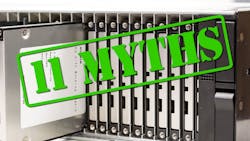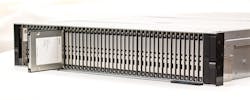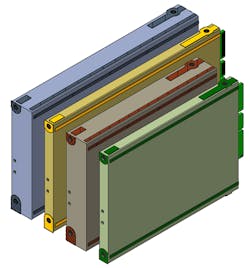11 Myths About New EDSFF E3 SSD Form Factors
What you’ll learn:
- Why new EDSFF form factors are misunderstood.
- Details about some commonly held EDSFF SSD myths.
- Insights into important design considerations for EDSFF SSDs.
The storage industry continues to churn out solid-state disk (SSD) innovations that increase storage density, flexibility, and performance for highly efficient data centers. The emergence of PCIe 5.0 technology as an SSD interface presents an inflection point for transitioning to new form-factor standards designed for future SSD generations.
Enterprise and Data Center Standard Form Factor (EDSFF) specifications create a new set of form factors that are designed around NAND flash memory. They yield many benefits when compared to existing form factors. Combining the PCIe 5.0 interface and EDSFF-specified E3 form factors are designed to enable higher-density servers and storage systems, optimization of PCIe lanes from CPUs, and ultra-high SSD performance for data centers of the future (Fig. 1).
Keep reading as we dispel some common myths about this transformative technology.
1. EDSFF SSDs are faster than 2.5-in.1 SSDs.
There are no design differences relating to EDSFF SSDs and 2.5-in. SSDs that make them perform at higher levels. At the same power delivery and interface speed, EDSFF and 2.5-in. SSDs should perform similarly. However, EDSFF SSDs allow for more than four lanes of the PCIe interface, as well as higher power delivery beyond 25 W, which enables higher performance versus 2.5-in. drives.
2. EDSFF SSDs are only targeted for high-performance applications.
EDSFF SSDs are a good match for high-performance applications, but that is not their only use-case. EDSFF form factors offer greater application flexibility when compared to 2.5-in. form factors due largely to their advanced connector and backplane design. The mechanical design changes to EDSFF SSDs improve drive thermal characteristics and server airflow, as well as enable higher-density servers through better component placement and cooling efficiencies. Though EDSFF SSDs are certainly targeted for high-performance applications, their design makes them applicable to many enterprise workloads.
3. An optimized server with 2.5-in. drives can house the same amount of EDSFF drives.
EDSFF SSDs can enable higher-density deployments than comparable 2.5-in. SSDs through smaller form factors, improvements to thermal management, and more efficient and robust connector packaging. Though there’s no direct comparison to the number of EDSFF versus 2.5-in. drives that a server can house, EDSFF form factors within a 2U platform can support a maximum between 44 and 46 EDSFF SSDs depending on the 2U chassis mechanical structure. It’s important to note that the number of drives that can be housed by a server depends on the chassis design.
4. PCIe 5.0 doesn’t allow for PCIe lane bifurcation.
Systems that utilize the PCIe interface can allocate lanes to PCIe devices depending on need. For example, the data-transfer performance for a single PCIe 5.0 lane is 32 gigatransfers per second (GT/s). When the encoding process is added, the performance equates to about 3.94 gigabytes per second (GB/s). Therefore, two lanes of the PCIe 5.0 interface can support up to 7.88 GB/s, which may be enough for certain SSD applications, enabling valuable PCIe interface bandwidth to be allocated for other devices. The system’s ability to bifurcate the PCIe 5.0 interface connection to two or four lanes depends on the host’s PCIe root complex capability.2
5. EDSFF SSDs support four PCIe lanes.
A single EDSFF connector physically supports up to four lanes, but devices aren’t required to utilize all four. EDSFF SSD flexible form factors can scale up to 16 lanes when a 4C configuration is used.
6. EDSFF SSDs are designed to replace 2.5-in. SSDs.
The E3 variations of EDSFF SSDs are designed to improve on the 2.5-in. form factor, while the E1 variants can be considered as an evolution of the M.2 form factor. Both E3 and E1 variations offer additional form-factor configurations that surpass the performance and capacity capabilities of existing 2.5-in. and M.2 form factors. E3 EDSFF SSDs come in four variants and include the key characteristics as follows:
7. EDSFF is a mechanical redesign of 2.5-in. drives that share the same connector.
Though the E3 EDSFF SSDs are similar in size to 2.5-inch form factors, the EDSFF connector is different in several ways. It can utilize different configurations (1C, 2C, 4C) that potentially support more PCIe lanes per device as well as support higher power envelopes. The connector is unified across all EDSFF form factors, enabling more storage flexibility versus the SFF-86393 (2.5-in. drive) connector.
8. Servers can’t fully utilize PCIe 5.0 performance.
Though it may be accurate that only two PCIe 5.0 x4 devices are needed to exceed the bandwidth of a 200-Gb Ethernet connection, systems can use the full PCIe 5.0 interface performance internally. For example, storage-class-memory (SCM) SSDs that are used as system cache can take advantage of the full PCIe 5.0 interface bandwidth. If a system doesn’t require the full PCIe 5.0 x4 performance per SSD, some platforms can configure SSDs to utilize only two lanes of the PCIe 5.0 interface, freeing up more lanes for other devices, such as peripheral compute and networking.
9. The PCIe 5.0 interface and EDSFF form factors must be used in conjunction with each other.
There are no limitations within the EDSFF form-factor specification that require the PCIe 5.0 interface. Both technologies work well together, but both also yield tremendous benefits independently.
10. The PCIe 5.0 interface is only 1.25X the speed of the PCIe 4.0 interface.
For each PCIe interface generational change, the speed per lane is intended to double, as follows:
11. EDSFF doesn’t enable higher capacities when compared to a 2.5-in. drive, 15-mm form factor.
When comparing an EDSFF SSD with the E3.S (Short Thin) form factor to a 2.5-in. drive, the capacity per drive is very similar. However, the EDSFF specification includes provisions for both thicker and longer variations of the form factor that enable higher capacities than 2.5-in. SSDs (Fig. 2). A key advantage of the EDSFF form factor is its flexible design that allows for higher-density flash storage and more efficient SSD use.
PCIe is a registered trademark of PCI-SIG. All other company names, product names and service names may be trademarks or registered trademarks of their respective companies.
References
1. 2.5-in. indicates the form factor of the SSD and not the drive’s physical size.
2. The root complex capability in a PCIe system connects the CPU and memory subsystem to the PCIe switch fabric and generates transaction requests on behalf of the CPU.
3. The SFF-8639 interface (now regarded as U.2) is a computer interface standard for connecting SSDs to a computing system and includes the physical connector, electrical characteristics, and communication protocols.




